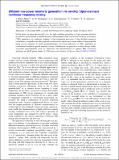| dc.contributor.author | Rakich, P. T. | |
| dc.contributor.author | Soljacic, Marin | |
| dc.contributor.author | Abad, J. B. | |
| dc.contributor.author | Rodriguez-Wong, Alejandro | |
| dc.contributor.author | Joannopoulos, John | |
| dc.contributor.author | Johnson, Steven G | |
| dc.date.accessioned | 2011-03-03T13:57:49Z | |
| dc.date.available | 2011-03-03T13:57:49Z | |
| dc.date.issued | 2010-03 | |
| dc.date.submitted | 2009-12 | |
| dc.identifier.issn | 1077-3118 | |
| dc.identifier.issn | 0003-6951 | |
| dc.identifier.uri | http://hdl.handle.net/1721.1/61380 | |
| dc.description.abstract | In this letter, we show theoretically how the light-confining properties of triply-resonant photonic resonators can be tailored to enable dramatic enhancements of the conversion efficiency of terahertz (THz) generation via nonlinear frequency down-conversion processes. Using detailed numerical calculations, we predict that this approach can be used to reduce up to three orders of magnitude the pump powers required to reach quantum-limited conversion efficiency of THz generation in conventional nonlinear optical material systems. Furthermore, we propose a realistic design readily accessible experimentally, both for fabrication and demonstration of optimal THz conversion efficiency at sub-W power levels. | en_US |
| dc.description.sponsorship | National Science Foundation (U.S.) (MRSEC DMR-0819762) | en_US |
| dc.description.sponsorship | United States. Army Research Office. Institute for Soldier Nanotechnologies (Contract No. W911NF-07-D-0004) | en_US |
| dc.language.iso | en_US | |
| dc.publisher | American Institute of Physics | en_US |
| dc.relation.isversionof | http://dx.doi.org/10.1063/1.3359429 | en_US |
| dc.rights | Article is made available in accordance with the publisher's policy and may be subject to US copyright law. Please refer to the publisher's site for terms of use. | en_US |
| dc.source | MIT web domain | en_US |
| dc.title | Efficient low-power terahertz generation via on-chip triply-resonant nonlinear frequency mixing | en_US |
| dc.type | Article | en_US |
| dc.identifier.citation | Bravo-Abad, J. et al. “Efficient low-power terahertz generation via on-chip triply-resonant nonlinear frequency mixing.” Applied Physics Letters 96.10 (2010): 101110-3. © 2010 American Institute of Physics | en_US |
| dc.contributor.department | Massachusetts Institute of Technology. Institute for Soldier Nanotechnologies | en_US |
| dc.contributor.department | Massachusetts Institute of Technology. Department of Mathematics | en_US |
| dc.contributor.department | Massachusetts Institute of Technology. Department of Physics | en_US |
| dc.contributor.approver | Johnson, Steven G. | |
| dc.contributor.mitauthor | Bravo-Abad, Jorge | |
| dc.contributor.mitauthor | Rodriguez, Alejandro W. | |
| dc.contributor.mitauthor | Joannopoulos, John D. | |
| dc.contributor.mitauthor | Johnson, Steven G. | |
| dc.contributor.mitauthor | Soljacic, Marin | |
| dc.relation.journal | Applied Physics Letters | en_US |
| dc.eprint.version | Final published version | en_US |
| dc.type.uri | http://purl.org/eprint/type/JournalArticle | en_US |
| eprint.status | http://purl.org/eprint/status/PeerReviewed | en_US |
| dspace.orderedauthors | Bravo-Abad, J.; Rodriguez, A. W.; Joannopoulos, J. D.; Rakich, P. T.; Johnson, S. G.; Soljačić, M. | en |
| dc.identifier.orcid | https://orcid.org/0000-0001-7327-4967 | |
| dc.identifier.orcid | https://orcid.org/0000-0002-7184-5831 | |
| dc.identifier.orcid | https://orcid.org/0000-0002-7244-3682 | |
| mit.license | PUBLISHER_POLICY | en_US |
| mit.metadata.status | Complete | |
